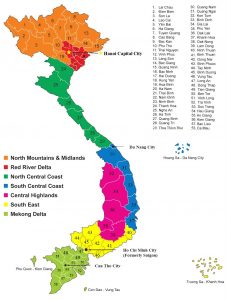Vietnam: Brief Information
Vietnam occupies a land area of 330,000 sq. km and measures 1,650 km from its northern border with China to its southernmost tip. It has 3,260 km of spectacular coastline.
Vietnam has two climates: the southern and central regions have a tropical climate with dry and rainy seasons and are normally humid throughout the year. In the north, the four seasons, including a distinct winter, are more defined. Average annual rainfall is about 223cm.
Vietnam population stands at around 82 million this year. The average population density is 227 people/sq. km. The annual growth rate is 2.1%. The literacy rate is about 90%. Approximately 70% of the population is employed in agriculture and more than half is under the age of 25.
Political structure: Vietnam is a socialist country under the leadership of the Communist Party. The Party holds a national congress every five years to outline the country’s overall direction and future course as well as to map out policies. The next Party’s Congress is planned in the first quarter 2001.
The National Assembly which includes 450 members as maximum, representing all walks of life throughout the country, and is open to non-Party members, is the highest state authority and the only body with constitutional and legislative power. The President of the State and the Prime Minister are elected by the National Assembly.
The President has the right to nominate candidates for a number of key positions; nominees are then approved by the National Assembly. The Prime Minister, who is in charge of the day-to-day handling of the government, has the right to nominate and dismiss the members of his cabinet, though only with the approval of the National Assembly. He also has at his disposal the power to cancel or suspend decisions or directives issued by the ministries. The Government now consists of 17 ministries and 12 ministerial agencies.
Vietnam is divided into 61 provinces and cities under the direct control of the central authority. Local People’s Councils are elected by the local population in each area. The Councils have the duty to maintain respect for the law, to carry out state policies and tasks. Local People’s Committees are the executive bodies of local People’s Councils. The Chairman, Vice Chairmen and members of the People’s Committee are elected by the People’s Council.

Map of Vietnam
Infrastructure: Decades of war and under-investment have left much of Vietnam’s infrastructure in a run-down state. By international comparative standards, the transport system in Vietnam is relatively under-developed and it has difficulty keeping up with the rise in trade volumes and economic growth.
Vietnam’s transport system consists of about 105,000 km of roads (the roads are generally narrow and of poor quality), 8 national seaports, 3 international airports and an additional number of smaller domestic airports.
The Government set a goal to reach the electricity output of 30-33 billion kWh this year. Large investments have been put in rehabilitating existing power plants, upgrading and expanding the transmission network as well as in constructing new power plants.
Vietnam now has three million telephones amongst the population, 8 earth satellite stations with direct communication channels with more than 40 countries and indirect connection with almost all the countries in the world. However, the telecommunication charge in Vietnam is relative expensive compared to other countries in the region despite the latest decision of the Government to reduce it by 15%.